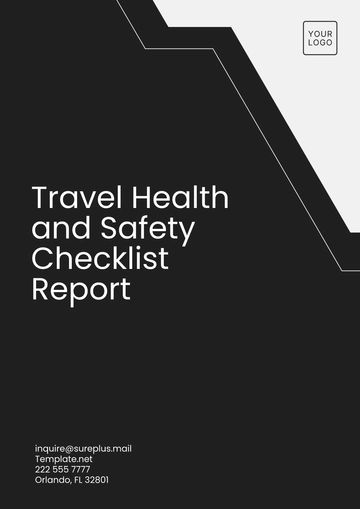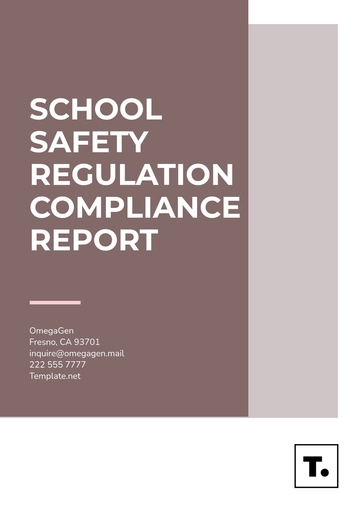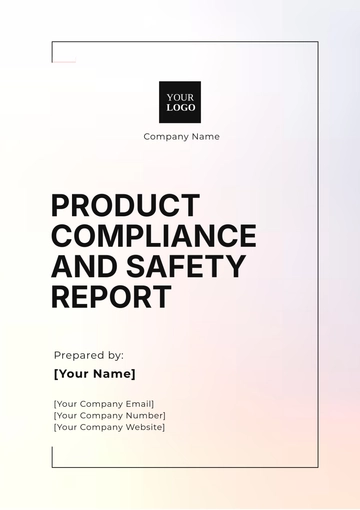Free Stakeholder Health and Safety Communication Report

Prepared by: [Your Name]
Company: [Your Company Name]
Date: January 17, 2052
1. Introduction
The purpose of this report is to outline the health and safety communication strategy for engaging stakeholders effectively. This report defines the scope and objectives of communication, identifies key stakeholders, and proposes methods to ensure ongoing awareness and compliance with health and safety standards.
2. Stakeholder Identification
This section identifies the various stakeholders involved in health and safety communication and their specific roles.
Employees: Primary group concerned with day-to-day health and safety practices.
Contractors: External workers who need to be informed about site-specific health and safety protocols.
Government Agencies: Regulatory bodies that require compliance and reporting.
Local Community: Residents and businesses who may be affected by the company’s health and safety practices.
Management: Senior leadership is responsible for ensuring that health and safety standards are met and communicated.
Suppliers: Organizations that provide equipment and materials critical to health and safety measures.
3. Communication Goals
The communication strategy aims to achieve the following goals:
Increase awareness of health and safety policies and risks.
Ensure stakeholders are informed about current health and safety standards and changes.
Encourage active participation and feedback from stakeholders regarding health and safety practices.
Promote adherence to health and safety protocols to reduce incidents and accidents.
4. Communication Strategy
The communication strategy will utilize a variety of methods tailored to the needs of each stakeholder group:
Meetings: Regular safety meetings with employees and contractors to discuss specific concerns and updates.
Email Updates: Timely notifications about new safety regulations, changes in protocols, or upcoming safety training.
Posters and Signage: Display health and safety posters in key areas where employees and visitors frequent.
Workshops and Training Sessions: Interactive safety training for employees and contractors.
Online Platforms: Use of digital platforms like intranet or safety management systems for real-time updates and safety tracking.
Surveys and Feedback Forms: Regular surveys to gather feedback on safety initiatives and identify areas for improvement.
5. Key Messages
The core messages to be communicated include:
Workplace Safety: Ongoing safety measures, including the use of personal protective equipment (PPE), safety audits, and emergency procedures.
Health Protocols: Guidelines for maintaining personal and collective health, especially in the context of COVID-19 or other infectious diseases.
Regulatory Compliance: Ensuring all health and safety practices align with local, national, and international standards.
Incident Reporting: Encouraging stakeholders to report any safety concerns, near misses, or hazards immediately.
Continuous Improvement: Reinforcing the importance of feedback for improving safety practices.
6. Engagement and Feedback Mechanisms
Effective communication requires active engagement. The following methods will be used to ensure stakeholder involvement:
Surveys and Focus Groups: To gather insights and opinions on current health and safety protocols.
Feedback Boxes: Anonymous suggestion boxes placed in key locations to collect feedback on health and safety concerns.
Safety Committees: Engaging employees through safety committees to provide input on communication strategies and improvements.
Digital Platforms: An online portal where stakeholders can submit feedback or report safety issues.
7. Monitoring and Evaluation
To evaluate the effectiveness of communication efforts:
Engagement Metrics: Monitor attendance at safety meetings and training sessions.
Feedback Analysis: Review responses from surveys and feedback channels to assess satisfaction and understanding.
Incident Rates: Track the frequency of incidents before and after communication campaigns to determine if awareness and compliance have improved.
Surveys: Post-training surveys to gauge understanding of communicated health and safety messages.
8. Challenges and Mitigation
Potential challenges and solutions include:
Language Barriers: Providing translated materials and interpreters for non-native speakers to ensure everyone understands the health and safety protocols.
Resistance to Change: Overcoming reluctance to new safety measures by highlighting the benefits and ensuring clear communication from leadership.
Technology Limitations: Ensuring that digital platforms are accessible to all stakeholders, particularly those who may not be tech-savvy.
9. Action Plan
The following action plan outlines the steps for implementing the communication strategy:
Action | Responsible Party | Timeline |
|---|---|---|
Stakeholder identification | Safety Manager | Week 1 |
Develop key messages | Communications Team | Week 2 |
Design and distribute materials | Design Team | Week 3 |
Organize workshops and meetings | Training Coordinator | Ongoing |
Launch surveys and feedback forms | HR Department | Monthly |
Evaluate and report effectiveness | Safety Manager | Quarterly |
10. Conclusion and Recommendations
This report outlines a comprehensive strategy for engaging stakeholders in health and safety communication. By utilizing a range of communication methods tailored to specific stakeholder needs, we aim to improve safety awareness and adherence to health protocols. To further enhance the communication strategy, it is recommended to:
Increase the frequency of safety updates for contractors and suppliers.
Implement more interactive training methods, such as virtual reality simulations for emergency response.
Continuously review and refine the communication methods based on feedback and incident trends.
- 100% Customizable, free editor
- Access 1 Million+ Templates, photo’s & graphics
- Download or share as a template
- Click and replace photos, graphics, text, backgrounds
- Resize, crop, AI write & more
- Access advanced editor
Streamline stakeholder communication with Template.net's Stakeholder Health and Safety Communication Report Template. Fully editable and customizable, this template ensures clear and professional reporting. Effortlessly tailor details to your needs using our AI Editor Tool. Simplify health and safety management while maintaining precision and compliance. Save time and improve communication effectiveness with this versatile, user-friendly resource.
You may also like
- Sales Report
- Daily Report
- Project Report
- Business Report
- Weekly Report
- Incident Report
- Annual Report
- Report Layout
- Report Design
- Progress Report
- Marketing Report
- Company Report
- Monthly Report
- Audit Report
- Status Report
- School Report
- Reports Hr
- Management Report
- Project Status Report
- Handover Report
- Health And Safety Report
- Restaurant Report
- Construction Report
- Research Report
- Evaluation Report
- Investigation Report
- Employee Report
- Advertising Report
- Weekly Status Report
- Project Management Report
- Finance Report
- Service Report
- Technical Report
- Meeting Report
- Quarterly Report
- Inspection Report
- Medical Report
- Test Report
- Summary Report
- Inventory Report
- Valuation Report
- Operations Report
- Payroll Report
- Training Report
- Job Report
- Case Report
- Performance Report
- Board Report
- Internal Audit Report
- Student Report
- Monthly Management Report
- Small Business Report
- Accident Report
- Call Center Report
- Activity Report
- IT and Software Report
- Internship Report
- Visit Report
- Product Report
- Book Report
- Property Report
- Recruitment Report
- University Report
- Event Report
- SEO Report
- Conference Report
- Narrative Report
- Nursing Home Report
- Preschool Report
- Call Report
- Customer Report
- Employee Incident Report
- Accomplishment Report
- Social Media Report
- Work From Home Report
- Security Report
- Damage Report
- Quality Report
- Internal Report
- Nurse Report
- Real Estate Report
- Hotel Report
- Equipment Report
- Credit Report
- Field Report
- Non Profit Report
- Maintenance Report
- News Report
- Survey Report
- Executive Report
- Law Firm Report
- Advertising Agency Report
- Interior Design Report
- Travel Agency Report
- Stock Report
- Salon Report
- Bug Report
- Workplace Report
- Action Report
- Investor Report
- Cleaning Services Report
- Consulting Report
- Freelancer Report
- Site Visit Report
- Trip Report
- Classroom Observation Report
- Vehicle Report
- Final Report
- Software Report





























